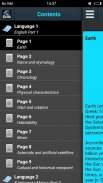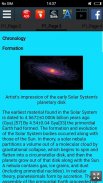








Earth Ebook

คำอธิบายของEarth Ebook
Earth (otherwise known as the world,[n 5] in Greek: Γαῖα Gaia,[n 6] or in Latin: Terra[26]) is the third planet from the Sun, the densest planet in the Solar System, the largest of the Solar System's four terrestrial planets, and the only astronomical object known to harbor life.
According to radiometric dating and other sources of evidence, Earth formed about 4.54 billion years ago.[27][28][29] Earth gravitationally interacts with other objects in space, especially the Sun and the Moon. During one orbit around the Sun, Earth rotates about its own axis 366.26 times, creating 365.26 solar days or one sidereal year.[n 7] Earth's axis of rotation is tilted 23.4° away from the perpendicular of its orbital plane, producing seasonal variations on the planet's surface with a period of one tropical year (365.24 solar days).[30] The Moon is Earth's only permanent natural satellite. Its gravitational interaction with Earth causes ocean tides, stabilizes the orientation of Earth's rotational axis, and gradually slows Earth's rotational rate.[31]
Earth's lithosphere is divided into several rigid tectonic plates that migrate across the surface over periods of many millions of years. 71% of Earth's surface is covered with water,[32] with the remainder consisting of continents and islands that together have many lakes and other sources of water that contribute to the hydrosphere. Earth's polar regions are mostly covered with ice, including the Antarctic ice sheet and the sea ice of the Arctic ice pack. Earth's interior remains active with a solid iron inner core, a liquid outer core that generates the magnetic field, and a convecting mantle that drives plate tectonics.
Within its first billion years,[33] life appeared in Earth's oceans and began to affect its atmosphere and surface, leading to the proliferation of aerobic and anaerobic organisms. Since then, the combination of Earth's distance from the Sun, its physical properties and its geological history have allowed life to thrive and evolve. The earliest undisputed life on Earth arose at least 3.5 billion years ago. Earlier physical evidence of life includes biogenic graphite in 3.7 billion-year-old metasedimentary rocks discovered in southwestern Greenland, as well as "remains of biotic life" found in 4.1 billion-year-old rocks in Western Australia.[34][35] Earth's biodiversity has expanded continually except when interrupted by mass extinctions.[36] Although scholars estimate that over 99% of all species of life (over five billion)[37] that ever lived on Earth are extinct,[38][39] there are still an estimated 10–14 million extant species,[40][41] of which about 1.2 million have been documented and over 86% have not yet been described.[42] More recently, in May 2016, scientists reported that 1 trillion species are estimated to be on Earth currently with only one-thousandth of one percent described.[43] Over 7.3 billion humans[44] live on Earth and depend on its biosphere and minerals for their survival. Earth's human population is divided among about 200 sovereign states that interact through diplomacy, conflict, travel, trade, and communication media.
โลก (หรือที่เรียกว่าโลก [N 5] ในภาษากรีก: Γαῖα Gaia, [N 6] หรือในละติน: Terra [26]) เป็นดาวเคราะห์ที่สามจากดวงอาทิตย์ดาวเคราะห์ที่หนาแน่นที่สุดในระบบสุริยะที่ใหญ่ที่สุดของ ระบบสุริยะสี่ดาวเคราะห์โลกและมีเพียงวัตถุทางดาราศาสตร์ที่รู้จักกันท่าเรือชีวิต
ตามที่ radiometric สืบและแหล่งอื่น ๆ ของหลักฐานโลกที่เกิดขึ้นเกี่ยวกับ 4540000000 ปีที่ผ่านมา. [27] [28] [29] แรงโน้มถ่วงโลกมีปฏิสัมพันธ์กับวัตถุอื่น ๆ ในพื้นที่โดยเฉพาะอย่างยิ่งดวงอาทิตย์และดวงจันทร์ ในช่วงหนึ่งวงโคจรรอบดวงอาทิตย์โลกหมุนรอบแกนของตัวเอง 366.26 ของเวลา, การสร้าง 365.26 วันแสงอาทิตย์หรือดาวฤกษ์ปีหนึ่ง. [N 7] แกนโลกของการหมุนเอียง 23.4 °ห่างจากตั้งฉากของระนาบวงโคจรของการผลิตการเปลี่ยนแปลงตามฤดูกาลใน พื้นผิวของดาวเคราะห์ที่มีระยะเวลาของปีสุริยคติหนึ่ง (365.24 วันแสงอาทิตย์) ได้. [30] ดวงจันทร์ของโลกเป็นเพียงบริวารถาวร ปฏิสัมพันธ์แรงโน้มถ่วงกับโลกทำให้เกิดกระแสน้ำในมหาสมุทร, การรักษาทิศทางของแกนหมุนของโลกและค่อยๆช้าอัตราการหมุนของโลก. [31]
เปลือกโลกของโลกแบ่งออกเป็นหลายแผ่นเปลือกโลกแข็งที่ย้ายข้ามพื้นผิวในช่วงระยะเวลาของหลายล้านปี 71% ของพื้นผิวโลกถูกปกคลุมด้วยน้ำ [32] กับส่วนที่เหลือประกอบด้วยทวีปและหมู่เกาะที่ร่วมกันมีทะเลสาบมากมายและแหล่งข้อมูลอื่น ๆ ของน้ำที่นำไปสู่การอุทก ของโลกบริเวณขั้วโลกถูกปกคลุมไปด้วยน้ำแข็งส่วนใหญ่รวมทั้งแผ่นน้ำแข็งแอนตาร์กติกและน้ำแข็งในทะเลของแพ็คน้ำแข็งอาร์กติก การตกแต่งภายในของโลกยังคงใช้งานกับแกนเหล็กแข็งภายในแกนนอกของเหลวที่สร้างสนามแม่เหล็กและเสื้อคลุม convecting ที่ไดรฟ์แผ่นเปลือกโลก
ภายในพันล้านปีแรก [33] ชีวิตปรากฏตัวขึ้นในมหาสมุทรของโลกและเริ่มที่จะส่งผลกระทบต่อบรรยากาศและพื้นผิวของมันนำไปสู่การแพร่กระจายของสิ่งมีชีวิตและแอโรบิกแบบไม่ใช้ออกซิเจน ตั้งแต่นั้นมารวมกันของระยะทางของโลกจากดวงอาทิตย์คุณสมบัติทางกายภาพและหลักฐานทางประวัติศาสตร์ที่ได้รับอนุญาตให้ใช้ชีวิตในการเจริญเติบโตและพัฒนา ชีวิตไม่มีปัญหาที่เก่าแก่ที่สุดในโลกเกิดขึ้นอย่างน้อย 3.5 พันปีที่ผ่านมา หลักฐานทางกายภาพก่อนหน้านี้ของชีวิตรวมถึงกราไฟท์ตะกอนหิน metasedimentary 3700000000 ปีค้นพบในทางตะวันตกเฉียงใต้ของเกาะกรีนแลนด์, เช่นเดียวกับ "ส่วนที่เหลือของชีวิตของสิ่งมีชีวิต" ที่พบในหิน 4100000000 ปีในออสเตรเลียตะวันตก. [34] [35] ความหลากหลายทางชีวภาพของโลกมีการขยายตัวต่อเนื่องยกเว้นเมื่อขัดจังหวะด้วยการสูญพันธุ์ครั้งใหญ่. [36] แม้ว่านักวิชาการประเมินว่ากว่า 99% ของทุกสายพันธุ์ของสิ่งมีชีวิต (กว่าห้าพันล้าน) [37] ที่เคยอาศัยอยู่บนโลกกำลังจะสูญพันธุ์ [38] [39] มี ยังคงประมาณ 10-14000000 ที่ยังหลงเหลืออยู่สายพันธุ์ [40] [41] ซึ่งประมาณ 1.2 ล้านคนได้รับการรับรองและกว่า 86% ยังไม่ได้รับการอธิบาย. [42] เมื่อเร็ว ๆ นี้ในเดือนพฤษภาคมปี 2016 นักวิทยาศาสตร์รายงานว่า 1 ล้านล้าน ชนิดที่คาดว่าจะอยู่บนโลกในปัจจุบันที่มีเพียงหนึ่งในพันของหนึ่งเปอร์เซ็นต์อธิบาย. [43] กว่า 7300000000 มนุษย์ [44] มีชีวิตอยู่บนโลกและขึ้นอยู่กับ Biosphere และแร่ธาตุของมันเพื่อความอยู่รอดของพวกเขา ประชากรมนุษย์ในโลกถูกแบ่งออกเป็นประมาณ 200 รัฐอธิปไตยที่โต้ตอบผ่านการทูต, ความขัดแย้ง, การเดินทางการค้าและการสื่อสาร

























